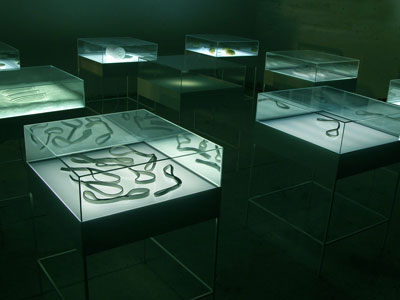'Rosengarten' returns for Hunter Tercentenary
Rosengarten
Until 20 January 2019
Hunterian Art Gallery
Admission free
 The William Hunter Tercentenary in 2018 has offered the perfect opportunity for The Hunterian to show a key installation from its contemporary art collection.
The William Hunter Tercentenary in 2018 has offered the perfect opportunity for The Hunterian to show a key installation from its contemporary art collection.
Rosengarten is currently on display at the Hunterian Art Gallery and runs in parallel with William Hunter and the Anatomy of the Modern Museum and Strange Foreign Bodies – two exhibitions that mark the Hunter Tercentenary and consider medical and anatomical subjects. All three exhibitions are open over the Christmas and New Year holidays.
Both Rosengarten and Strange Foreign Bodies offer 21st century responses to Hunterian founder, Dr William Hunter’s collections, life and work. The exhibitions also showcase the work of leading contemporary artists and writers including Anne Bevan, Janice Galloway, Claire Barclay and Christine Borland.
Rosengarten is a unique combination of visual art and literature, bringing together the sculpture of Anne Bevan and the words of Janice Galloway, two of Scotland’s foremost artists in their fields. It consists of nine custom-made cases, lit from inside and containing Anne Bevan’s delicate sculptures, forming the core of the exhibit: the walls carry nine of Janice Galloway's texts on blue printed felt.
Inspired by obstetric implements, Rosengarten looks at the tools of birthing. Bevan and Galloway, who have worked together on a number of occasions, researched the work with a number of important medical historic collections, including those of The Hunterian, and leading contemporary obstetricians and their teams.
The nine specially made Perspex-topped light boxes contain beautifully shaped and crafted forms. The very precision and fragility of these forms, in glass, plastic and a number of natural substances including mother-of-pearl and sponge, transforms them from being clinically functional (and, because of their origins, frequently somewhat frightful) into objects of beauty.
Fully acknowledging the metallic and cold forms of the man-made instruments from which they take their inspiration, these emerge, through the creative collaboration between Bevan and Galloway, to take on a richer, more poetic and metaphorical countenance.
Rosengarten reflects powerfully the human and tender emotions of mother and baby that run parallel to the hard and frequently interventive experiences associated with modern childbirth.
This beautiful and intriguing work strongly resonates with the William Hunter and the Anatomy of the Modern Museum exhibition, also on display at the Hunterian Art Gallery. The major exhibition displays a number of items from the medical collections gathered by Dr William Hunter (1718–1783), one of the leading obstetricians of the 18th century who devoted a lifetime to the advancement of medical knowledge.
It includes four of Hunter’s plaster cast models, now fully restored, which show the various stages of the pregnant human womb in progressive states of dissection, in graphic and stunning naturalistic detail. The casts were used in preparation for Hunter’s great publication Anatomia Uteri Humani Gravidi Tabulis Illustrate, (Anatomy of the Gravid Uterus Exhibited in Figures, 1774) – a work which remains a cornerstone in the development of modern obstetrical science.
The name Rosengarten comes from Der Swangern Frauwen und Hebammen Rosengarten, the first illustrated manual of midwifery, produced by Eucharius Rösslin in 1513. The advent of the printing press allowed Rösslin to publish the book in German so midwives who were unversed in Latin, might read it, or as the book advises, have it read to them by a ‘well-read woman’. The title of the book, Rosengarten, means The Rose Garden.
Rosengarten is on display at the Hunterian Art Gallery until 20 January 2019. It premiered at the Hunterian Museum in January 2004 and was added to The Hunterian collection in 2005 with funds from the National Collecting Scheme for Scotland and a grant from the Art Fund.
A book, Rosengarten, by Janice Galloway, is also available and combines poetry and short stories based on the history of birthing.
Hunterian Art Gallery
University of Glasgow
82 Hillhead Street
Glasgow G12 8QQ
Open Tuesday – Saturday 10.00am – 5.00pm and Sunday 11.00am – 4.00pm
www.glasgow.ac.uk/hunterian
Image © Michael Wolchover/Anne Bevan.
For further information contact:
Mungo Campbell, Deputy Director, The Hunterian
For images contact:
Harriet Gaston, Communications Manager, The Hunterian, or download a selection from our Press Image section.
Notes to Editors
Festive Opening Hours
The Hunterian Museum, Hunterian Art Gallery and Mackintosh House will be closed from 4.00pm on Sunday 23 December 2018. They will be open from 10.00am – 5.00pm on Thursday 27, Friday 28, and Saturday 29 December, and 11.00am – 4.00pm on Sunday 30 December 2018. All will then close from 31 December 2018, re-opening on 3 January 2019.
The Hunterian
The Hunterian is one of the world's leading University museums and one of Scotland’s greatest cultural assets. Built on Dr William Hunter’s founding bequest, The Hunterian collections include scientific instruments used by James Watt, Joseph Lister and Lord Kelvin; outstanding Roman artefacts from the Antonine Wall; major natural and life sciences holdings; Hunter’s own extensive anatomical teaching collection; one of the world’s greatest numismatic collections and impressive ethnographic objects from Captain Cook’s Pacific voyages.
The Hunterian is home to one of the most distinguished public art collections in Scotland and features the world’s largest permanent display of the work of James McNeill Whistler, the largest single holding of the work of Scottish artist, architect and designer Charles Rennie Mackintosh (1868–1928) and The Mackintosh House, the reassembled interiors from his Glasgow home.
The Hunterian has also developed an important collection of works by leading contemporary artists including Lucy Skaer, Ilana Halperin, Mat Collishaw, Mark Dion and Christine Borland.
glasgow.ac.uk/hunterian
First published: 18 December 2018

